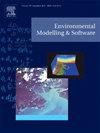每日高分辨率全遥感蒸散的GEE TSEB工作流程:在半干旱条件下对四种作物的验证以及与SSEBop实验产品的比较
IF 4.8
2区 环境科学与生态学
Q1 COMPUTER SCIENCE, INTERDISCIPLINARY APPLICATIONS
引用次数: 0
摘要
准确而全面的蒸散发估算对水资源管理至关重要。采用谷歌Earth Engine工作流来估算每日30米的ET。该算法采用Landsat和ERA5-Land数据集,包括两源能量平衡(TSEB)模型、叶面积指数人工神经网络和基于作物系数的间隙填充方法。利用摩洛哥半干旱地区的四个通量塔(小麦、玉米、西瓜、橄榄)对产出进行了评估,并与另一个高分辨率ET (SSEBop产品)进行了比较。结果显示出良好的性能(RMSE在0.67 mm/day和2 mm/day之间,MBE较低),而SSEBop产品通常低估了ET。当将ET聚合到周和月时间尺度时,发现TSEB-GEE工作流的性能更好。该工作流程简化了模型的实施,提供了可靠的每日地块尺度ET估算,为在半干旱的地中海地区更广泛的应用提供了潜力,包括各种作物,并促进了历史分析。本文章由计算机程序翻译,如有差异,请以英文原文为准。

A GEE TSEB workflow for daily high-resolution fully remote sensing evapotranspiration: Validation over four crops in semi-arid conditions and comparison with the SSEBop experimental product
Accurate and synoptic estimation of Evapotranspiration (ET) is crucial for water management. A Google Earth Engine workflow is implemented to estimate daily ET at 30m. The algorithm uses Landsat and ERA5-Land datasets and includes the Two Source Energy Balance (TSEB) model, an Artificial Neural Network for Leaf Area Index, and a gap-filling approach based on crop coefficient. The outputs were evaluated against four local flux towers in a semi-arid site in Morocco (wheat, maize, watermelon, olive), and compared to another high-resolution ET (SSEBop product). The results demonstrated good performances (RMSE between 0.67 mm/day and 2 mm/day, low MBE), while SSEBop product generally underestimated ET. Better performance of the TSEB-GEE workflow was found when aggregating ET to weekly and monthly timescales. The workflow offers ease of model implementation to deliver reliable daily plot-scale ET estimates, offering the potential for broader-scale applications in semi-arid Mediterranean regions, encompassing various crops and facilitating historical analysis.
求助全文
通过发布文献求助,成功后即可免费获取论文全文。
去求助
来源期刊

Environmental Modelling & Software
工程技术-工程:环境
CiteScore
9.30
自引率
8.20%
发文量
241
审稿时长
60 days
期刊介绍:
Environmental Modelling & Software publishes contributions, in the form of research articles, reviews and short communications, on recent advances in environmental modelling and/or software. The aim is to improve our capacity to represent, understand, predict or manage the behaviour of environmental systems at all practical scales, and to communicate those improvements to a wide scientific and professional audience.
 求助内容:
求助内容: 应助结果提醒方式:
应助结果提醒方式:


